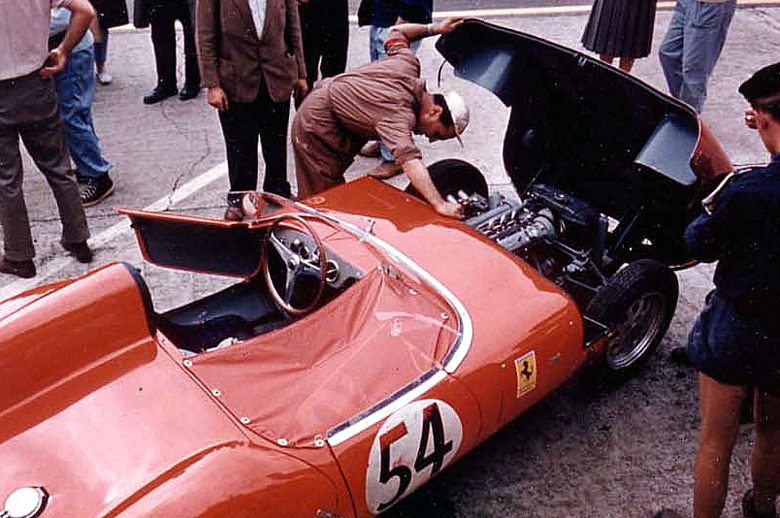
The OSCA factory mechanic makes some last minute adjustments on the Gordon-Bentley rent-a-ride. Note the NART shield on the OSCA.
By Jack Gordon with Pete Vack
Photos courtesy of Jack Gordon
Originally published in VeloceToday on June 24, 2009
Forty-nine years ago, John Bentley and John “Jack” Gordon bought OSCA 750, chassis 769, and entered it at Sebring, where they placed 12th overall and won the Index of Performance. On a roll, they decided to go to Le Mans and try to duplicate their amazing success at Sebring. Jack Gordon picks up the narrative here in this exclusive for VeloceToday.
With Sebring packed away it was time to plan the next move.
It was now late March and we were informed that all the entries for Le Mans were closed and they wouldn’t give us a late entry. It would have been nice to repeat the dual Index wins of de Tomaso.
[In 1958 Alejandro de Tomaso won the Index at Sebring with his wife Elizabeth Haskell, driving OSCA chassis number 760. Then he won the Index at Le Mans a couple months later, driving OSCA 750 chassis 762 with Colin Davis]. But in any case there was too little time to tear down and recondition our car for a 24-hour event.
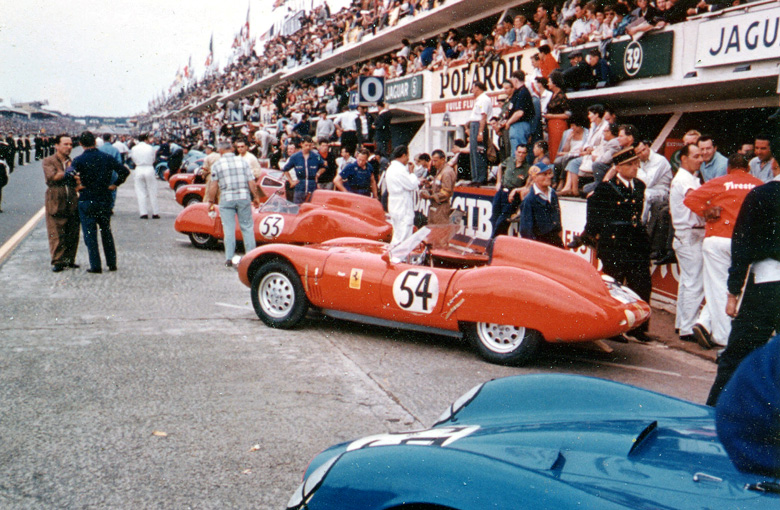
Gordon’s OSCA number 54 waiting for the start. Next to the OSCA, number 53 is a streamliner-bodied OSCA 750, chassis 761, driven by Laroche/Simon. “I was under the impression the front body section was an after-market modification done in France, as I had never heard of any original Morelli bodies having this configuration,” said Gordon.
Fortunately Luigi Chinetti was willing to rent his NART OSCA 750 (Chassis 768) entry to us, for a fee of $1000 per driver. It was already entered with no named drivers, and saved us the trouble and expense of air freighting the car back and forth to France. Plus, we figured that it would have been a shame to have done all that and then have the crummy French fuel burn a hole in the piston of our OSCA.
We flew to Paris and did some sightseeing at Chartres on the way over to Le Mans. We arranged lodgings in a private home in the city. Arriving at the track, I took my usual SCCA driving coveralls, blue Pirellis purchased through Columbia Motors (they had such a wonderful stock of stuff for all the British and Italian cars) and my white Snell-approved helmet. Nobody in Europe had seen getup like this before – lots of snickering about those sissy Americans with huge crash helmets.
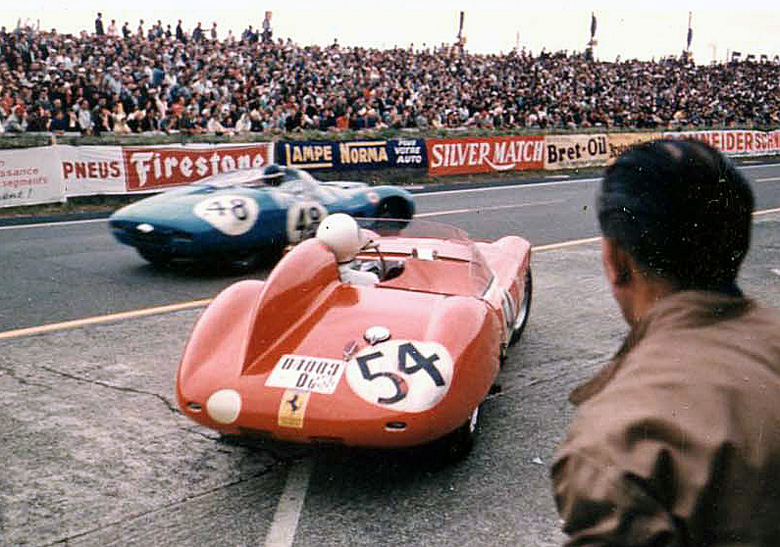
Bentley takes the first stint, and is just getting underway. In front of him is the Laureau-Amagnac D.B. Panhard, which would win the Index of Performance.
Practice began with a car which was not quite a replica of our chassis 769; it had five bolt wheels like an 1100 but the engine looked identical to our engine number 774. (We later learned that this was the Fulp/Cunningham car that had finished 2nd in class at Sebring.) The car was equipped with Pirelli Supersports with which I was not familiar (I raced my 1957 Alfa Spider mostly with Michelin X tires). It turned out that these Pirellis require quite a bit of scuffing-in before they have any cornering power, so I embarrassed myself by sticking the nose in the sandbank at Mulsanne corner but no harm done mechanically. Bentley did the same later in the evening but went over the earth bank completely at Indianapolis, and cutting his nose on his visor. It later got infected, sanitation in the provinces being what it was.
The car was definitely down on power and the factory mechanics seem not to be able to do anything about it. It felt lean and late, like it was putting out only about 50 hp. I discussed this with the French driver of the other 750 entry, Jean Laroche, and he told me, “Jack if you don’t have it on the straights here you will never make up for that in the corners.” Truer words were never spoken. They had the streamliner body with fairings over the front wheels, but retired early.
I was rather annoyed with Signor Chinetti for providing a ride which was less-well prepared than our own car. Perhaps they detuned it to cope with the low-octane French gasoline that everyone was required to use.
The race began at 4 pm and Bentley took the first 3 hour shift. It occurred to me then that this is going to be tedious. At the 3 hour point we were running 44th overall, this was only because there were 5 retirements out of the 55 starters. My shift was up and pretty soon it began to rain. I normally raced with aircraft style goggles and I had my yellow plano-type glasses my father used for deer hunting. These gave me a visual advantage over the other drivers, with a similar effect as the yellow lenses of foglights. I also found that I was tall enough in the saddle to see over that ridiculous FIA windshield and that proved to be a real plus under those conditions.
The rain got heavier. The Pirellis were by now well-scuffed in and confidence rose. Going up the hill after the pits to the Dunlop Bridge (a fast right curve) I could put my right wheels over the yellow-painted line and get wheelspin! I thought, who ever heard of a 750cc needing a limited-slip rear?
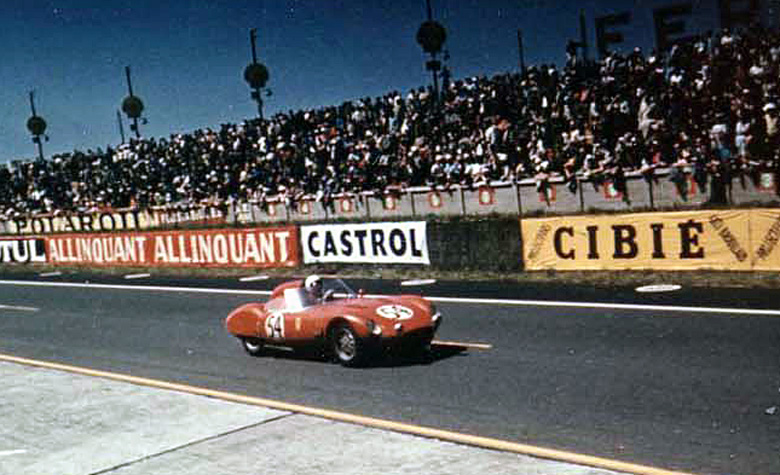
Le Mans can be lonely and tedious. After the rain, the sun came out for the last few hours of the event. Gordon wore a polo shirt and still remembers the sunburn.
We had Sammy Davis (You do remember Sammy Davis don’t you? The 73 year-old icon was most famous for winning the 1927 Le Mans in a Bentley. His son Colin raced OSCAs.) in our pit crew. I came in at the 6 hour point and we were 42d overall. Sammy says to Bentley, “Where did you get this guy?” I guess he was impressed. Later, I found that racing in the rain gave me an advantage because my driving style was smoother than the others.
Now for a thermodynamics lesson. An engine runs stronger in the rain (up to the point of drowning the ignition) because the air density tends to be higher and steam is a more efficient working fluid in a cycle than nitrogen. There is a long explanation but trust me, it’s true. And useful information when driving at Le Mans.
Nothing much happened from this point, the rain eased up, we swapped drivers a few more times, and there was the usual early morning fog at 3 am but nothing unmanageable. I distinctly recall getting a tow down the Mulsanne straight from Mike Rothschild driving one of the team Triumph Twin Cams (with the original aluminum Michelotti TR 4 body style). The OSCA rev counter climbed way past the redline–getting a tow was pretty impressive, there was lots of negative pressure right behind that brick-like Triumph. I drove my last shift in a golf shirt rather than my coveralls and got a pretty good sunburn on my left arm. At 4 pm–after 24 hours, we finished 18th among the classified finishers but in front of two of the 850 cc D.B. Panhards, if that is any satisfaction. We didn’t win the Index but placed third, and second in the 850 class.
The organizers passed out medals to the survivors and gave Signor Chinetti some prize money for our podium finish on Index. I insisted on getting my share of the money but Signor Chinetti was reluctant. He said he would give me a ride in a Ferrari Berlinetta next year if I passed up the money. I declined his offer, not being sure if he was really serious.
I think the funniest part of the whole weekend was watching the Grossman-Fitch Corvette coming in every 10 laps on Sunday afternoon for a full load of ice cubes in the engine bay in addition to topping up the radiator. The rules required a lock seal on all fluids and a minimum 10 laps between additions. But rules said nothing about adding 200 pounds of ice cubes. The officials were totally flummoxed by this one; of course it only works on a big V8. Being a General Motors product with cast-iron heads and no valve-seat inserts the poor thing burned all its valves pretty badly. They finished 8th overall, quite remarkable under the circumstances
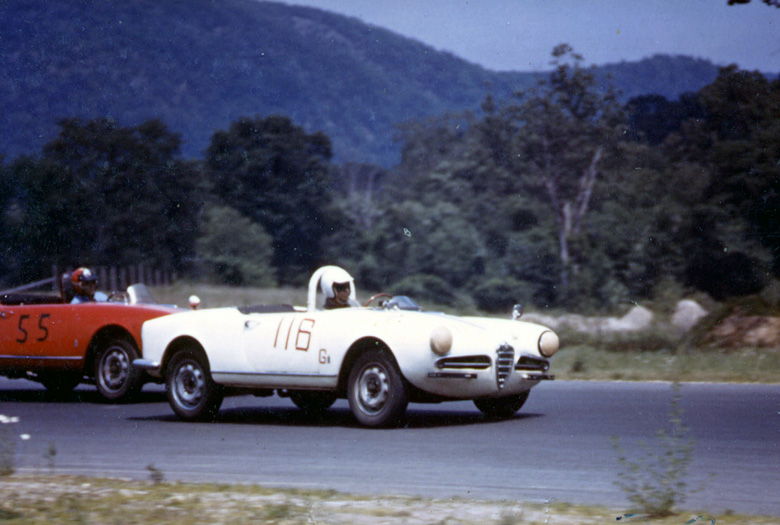
Gordon came home and continued to race his Alfa Spider in SCCA events like this one at Lime Rock. Strictly amateur only, no one in the club bothered him about winning prize money at Sebring or Le Mans.
When I returned home, I expected to have my SCCA license pulled because I had accepted prize money twice–at Sebring and Le Mans. I ran a few local events in the Alfa, nobody said anything. But now we were left with the decision regarding our own OSCA. Karl Ludvigsen wanted to do a story on the car, so we took it up to Thompson in northeast Connecticut on practice day and ran it around and took some pictures. The story appeared a few months later in Sports Cars Illustrated. The saga of OSCA 769 didn’t end there…far from it. We’ll save that for another time, another page.